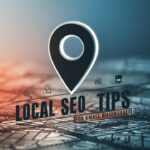In the digital age, establishing a strong online presence has become paramount for individuals and businesses alike. The internet serves as a vast landscape where people connect, share information, and make decisions. Whether you’re a business aiming to reach a broader audience or an individual looking to showcase your skills, having a robust digital presence is key to success.
Brief Overview of the Importance of Digital Presence
- Global Reach: The internet allows you to transcend geographical boundaries, enabling you to connect with people worldwide. This global reach is particularly crucial for businesses seeking to expand their customer base beyond local markets.
- Credibility and Trust: An online presence builds credibility and trust. Consumers often research products, services, or individuals online before making decisions. A well-managed digital presence can enhance your reputation and instill confidence in your audience.
- 24/7 Accessibility: Unlike traditional brick-and-mortar establishments, the digital realm operates 24/7. This constant accessibility means that your information is available to potential customers or collaborators at any time, regardless of their location or time zone.
- Communication and Engagement: Social media, websites, and other online platforms provide avenues for direct communication with your audience. Engaging with your community fosters relationships, gathers feedback, and creates a sense of connection.
SEO (Search Engine Optimization)
In the vast expanse of the internet, being visible is as important as being present. This is where Search Engine Optimization (SEO) comes into play.
- Definition of SEO: SEO is a set of practices aimed at optimizing a website or online content to improve its visibility in search engine results. The goal is to organically rank higher in search engines like Google, Bing, or Yahoo, making it more likely for users to find and visit your site.
- Importance of SEO:
- Increased Visibility: By optimizing your content, you increase the chances of your website appearing on the first page of search results, where most users are likely to click.
- Traffic Quality: SEO not only brings more traffic to your site but also attracts relevant visitors who are more likely to be interested in your content or offerings.
- Credibility: Websites that appear higher in search results are often perceived as more credible and trustworthy by users.
- Key SEO Elements:
- Keywords: Choosing and strategically using relevant keywords in your content.
- Content Quality: Creating high-quality, valuable, and relevant content.
- Link Building: Building a network of quality inbound links to your website.
- User Experience: Ensuring a positive experience for visitors through site speed, mobile responsiveness, and easy navigation.
A robust digital presence is fundamental in today’s interconnected world, and SEO plays a crucial role in ensuring that your online content doesn’t just exist but is also easily discoverable by your target audience. Understanding and implementing effective SEO strategies can significantly contribute to the success of your online endeavors.
The Significance of SEO
SEO and its Role in Online Visibility
Search Engine Optimization (SEO) is the practice of optimizing online content to improve its visibility on search engines. The primary goal is to increase organic (non-paid) traffic to a website by ensuring that it ranks higher in search engine results pages (SERPs). The process involves various strategies and techniques designed to align with search engine algorithms, making it easier for search engines to understand and rank the content.
- Relevance and Authority: SEO involves creating content that is not only relevant to user queries but also positions the website as an authoritative source in its industry or niche. This involves using strategic keywords, creating quality content, and building a network of credible backlinks.
- Technical Optimization: In addition to content, technical aspects of a website play a crucial role in SEO. This includes optimizing site structure, improving page load times, ensuring mobile responsiveness, and employing other technical best practices that contribute to a positive user experience.
- User Intent: SEO efforts focus on understanding and catering to user intent. By aligning content with what users are searching for, websites can attract the right audience and provide valuable solutions or information.
Statistics on the Impact of High Search Engine Rankings
- Click-Through Rates (CTR): Studies consistently show that websites appearing at the top of search results receive a significantly higher CTR. Users often click on one of the first few results, emphasizing the importance of a high search engine ranking.
- Trust and Credibility: Users tend to trust websites that appear prominently in search results. According to research, a website’s position in search rankings correlates with its perceived trustworthiness. A higher ranking implies credibility and authority.
- Traffic Distribution: A substantial portion of clicks goes to the top three search results. Statistics indicate that the first result alone often captures a significant percentage of clicks, highlighting the competitive advantage of securing a top-ranking position.
Importance of Organic Traffic
- Cost-Effectiveness: Organic traffic, generated through SEO efforts, is cost-effective compared to paid advertising. While paid strategies can drive immediate traffic, organic traffic provides sustainable, long-term results without the ongoing expense of paid campaigns.
- User Engagement: Organic traffic is often more engaged and likely to convert. Visitors who find a website through organic search are actively seeking information or solutions, making them more receptive to the content and offerings.
- Algorithm Changes and Stability: Organic traffic is less susceptible to sudden changes in algorithms or advertising policies. Building a strong foundation through SEO ensures a level of stability, even as search engine algorithms evolve.
SEO is not just a technical aspect of online marketing; it is a fundamental strategy that significantly impacts a website’s visibility, credibility, and long-term success. The statistics on search engine rankings underscore the importance of investing in SEO to secure a competitive edge in the digital landscape. Additionally, the value of organic traffic lies in its sustainability, cost-effectiveness, and ability to attract an engaged audience actively seeking relevant information or products.
Understanding SEO Tools
Purpose of SEO Tools
SEO tools are software applications or online platforms designed to assist digital marketers, website owners, and SEO professionals in optimizing their online content to improve search engine rankings. These tools help streamline various aspects of the SEO process, providing insights, data, and features that facilitate better decision-making and implementation of effective strategies.
- Purpose:
- Data Analysis: SEO tools collect and analyze data related to website performance, user behavior, and keyword trends.
- Optimization: They aid in optimizing on-page content, identifying keyword opportunities, and improving technical aspects of a website to enhance search engine visibility.
- Monitoring and Reporting: SEO tools track website rankings, monitor backlinks, and generate reports to assess the effectiveness of SEO efforts.
- Competitor Analysis: Many tools offer features for analyzing competitors’ strategies, keywords, and backlink profiles to inform your own SEO strategy.
Different Categories of SEO Tools
- Keyword Research Tools:
- On-Page Optimization Tools:
- Purpose: Assist in optimizing individual web pages for better search engine rankings.
- Functionality: Analyze content, suggest improvements, and ensure pages are well-structured.
- Examples: Yoast SEO (WordPress plugin), Screaming Frog SEO Spider, Moz On-Page Grader.
- Backlink Analysis Tools:
- Purpose: Examine the quality and quantity of backlinks pointing to a website.
- Functionality: Identify new backlink opportunities, assess competitor link profiles, and monitor existing links.
- Examples: Ahrefs, Majestic, Moz Link Explorer, SEMrush.
- Analytics Tools:
- Purpose: Track and analyze website performance, user behavior, and the impact of SEO efforts.
- Functionality: Provide data on traffic sources, user demographics, and other key metrics.
- Examples: Google Analytics, Adobe Analytics, Matomo.
Examples of Popular SEO Tools
- SEMrush:
- Features: Comprehensive suite including keyword research, site audit, backlink analysis, and competitor research.
- Ahrefs:
- Features: Known for robust backlink analysis, keyword research, and site auditing capabilities.
- Moz:
- Features: Offers tools for keyword research, on-page optimization, link analysis, and rank tracking.
- Google Analytics:
- Features: Provides in-depth insights into website traffic, user behavior, and conversion metrics.
- Yoast SEO:
- Features: A popular WordPress plugin for on-page optimization, providing real-time feedback on content.
- Screaming Frog SEO Spider:
- Features: Crawls websites to analyze on-page SEO elements and identify optimization opportunities.
These tools collectively empower digital marketers to make informed decisions, track performance, and implement effective strategies to improve a website’s visibility in search engine results. Choosing the right combination of tools based on specific needs and objectives is crucial for a successful SEO campaign.
Improving Keyword Strategy
Importance of Keywords in SEO
Keywords play a pivotal role in the field of Search Engine Optimization (SEO). They are the terms and phrases that users enter into search engines when looking for information, products, or services. Understanding the importance of keywords is crucial for building a successful SEO strategy.
- Relevance and Visibility: Using relevant keywords in your content helps search engines understand the context and relevance of your pages. This, in turn, enhances the visibility of your content in search engine results.
- User Intent: Keywords reflect the intent of users. By aligning your content with the right keywords, you can attract visitors who are actively searching for what you offer, increasing the likelihood of engagement and conversion.
- Competitive Edge: A well-optimized keyword strategy can give you a competitive edge. By targeting specific keywords related to your niche or industry, you can outrank competitors and capture a larger share of your target audience.
How SEO Tools Aid in Keyword Research
SEO tools are instrumental in conducting effective keyword research. They provide valuable insights and data that help identify the most relevant and high-performing keywords for your content.
- Search Volume: Tools like Google Keyword Planner, SEMrush, and Ahrefs provide information on the search volume of specific keywords. This helps you understand how often users are searching for a particular term.
- Competition Analysis: SEO tools offer insights into the competition for specific keywords. This includes information on the difficulty of ranking for a keyword and the websites currently ranking for it.
- Keyword Variations and Suggestions: Many tools provide variations of a keyword and suggest related terms. This helps in expanding your keyword list and targeting a broader range of search queries.
- Long-Tail Keywords: SEO tools can identify long-tail keywords – longer and more specific phrases. While these may have lower search volume, they often indicate higher user intent and can be valuable for niche targeting.
Implementing Effective Keyword Strategies
- Understand Your Audience: Identify your target audience and understand their needs, preferences, and search behavior. This forms the foundation for choosing relevant keywords.
- Conduct Thorough Research: Use SEO tools to conduct thorough keyword research. Consider the search volume, competition, and relevance of each keyword to your content and business objectives.
- Focus on Long-Tail Keywords: While broad keywords are important, don’t neglect long-tail keywords. These often have less competition and can attract highly targeted traffic.
- Create High-Quality Content: Once you have identified your target keywords, create high-quality, informative, and engaging content around them. Ensure that your content provides value to users and aligns with their search intent.
- Optimize On-Page Elements: Incorporate your target keywords naturally into on-page elements such as titles, meta descriptions, headings, and throughout the content. This helps search engines understand the context of your pages.
- Monitor and Adjust: Regularly monitor the performance of your keywords using analytics tools. Adjust your strategy based on changes in search trends, user behavior, and the evolving competitive landscape.
- Stay Updated: The digital landscape is dynamic, and search engine algorithms evolve. Stay updated with industry trends and search engine updates to adapt your keyword strategy accordingly.
A well-crafted keyword strategy is essential for the success of your SEO efforts. By understanding the importance of keywords, leveraging SEO tools for research, and implementing effective strategies, you can enhance the visibility of your content and attract a relevant audience to your website.
Enhancing On-Page Optimization
Importance of On-Page Optimization for Search Engines
On-page optimization is a critical aspect of SEO that involves optimizing individual web pages to improve their visibility in search engine results. It directly influences how search engines understand and rank your content, making it crucial for achieving higher rankings and attracting organic traffic.
- Relevance and Context: On-page optimization ensures that your content is relevant to the targeted keywords and provides value to users. Search engines analyze on-page elements to determine the context and subject matter of a page.
- User Experience: Well-optimized pages contribute to a positive user experience. This includes factors such as fast loading times, mobile responsiveness, and easy navigation – all of which are considered by search engines in ranking algorithms.
- Crawlability and Indexing: Search engines use crawlers to navigate and index web pages. On-page optimization helps search engine crawlers understand the structure and content of your pages, ensuring proper indexing.
Role of SEO Tools in Optimizing Content and Meta Tags
SEO tools play a crucial role in streamlining the on-page optimization process by providing insights, analysis, and recommendations. Here’s how they contribute:
- Content Optimization:
- Keyword Density: Tools like Yoast SEO and SEMrush analyze your content for keyword usage, helping you maintain an optimal keyword density.
- Readability: Some tools assess the readability of your content, offering suggestions to improve user engagement.
- Meta Tags Optimization:
- Title Tags and Meta Descriptions: SEO tools like Yoast SEO and Moz provide real-time feedback on the length and relevance of title tags and meta descriptions.
- Header Tags: Tools can highlight the usage of header tags (H1, H2, etc.) and offer suggestions to improve the structure of your content.
- Technical SEO Analysis:
- Crawling and Indexing: Tools such as Screaming Frog SEO Spider help identify issues related to crawling and indexing, ensuring that search engines can access and index your pages.
- Mobile Optimization: SEO tools can assess the mobile-friendliness of your pages, considering the increasing importance of mobile search.
Tips for Effective On-Page Optimization Using SEO Tools
- Keyword Placement:
- Place primary keywords in strategic locations, including the title tag, meta description, and headings.
- Use variations of keywords naturally throughout the content.
- Content Quality:
- Create high-quality, valuable content that addresses the needs and interests of your target audience.
- Use tools to analyze content readability and make improvements for a broader audience.
- Meta Tags:
- Craft compelling and relevant title tags and meta descriptions for each page.
- Ensure that meta tags accurately reflect the content on the page.
- Header Tags:
- Use header tags to structure your content logically.
- Optimize header tags for both users and search engines.
- Image Optimization:
- Optimize images by using descriptive file names and alt attributes.
- Compress images to improve page loading times.
- URL Structure:
- Create clean and concise URLs that include relevant keywords.
- Avoid using dynamic URLs with excessive parameters.
- Internal Linking:
- Implement a logical internal linking structure to guide users and distribute link equity.
- Use tools to identify and fix broken internal links.
- Technical SEO:
- Regularly audit your website using tools like Screaming Frog to identify and address technical issues.
- Ensure that your site is secure (HTTPS) for improved security and search engine rankings.
- Monitor Performance:
- Use analytics tools to monitor the performance of your optimized pages.
- Track changes in rankings, traffic, and user engagement over time.
On-page optimization is integral to a successful SEO strategy, and SEO tools provide valuable assistance in the process. By implementing best practices, utilizing SEO tools for analysis and recommendations, and staying informed about industry trends, you can enhance the visibility and effectiveness of your web pages in search engine results.
Building Quality Backlinks
Backlinks in SEO
Backlinks, also known as inbound or incoming links, are links from one website to another. They play a crucial role in SEO, influencing a website’s visibility and authority in search engine rankings. The significance of backlinks lies in their ability to:
- Establish Authority: Search engines view backlinks as a vote of confidence from one site to another. The more reputable websites linking to your content, the more authoritative and trustworthy your site appears.
- Improve Ranking: Backlinks are a key factor in search engine algorithms. Websites with a higher number of high-quality backlinks tend to rank higher in search results for relevant queries.
- Increase Traffic: Quality backlinks can drive referral traffic to your site. When users click on a link from another website to yours, it not only enhances your site’s visibility but also brings potential new visitors.
- Crawl and Indexation: Backlinks assist search engine crawlers in discovering and indexing your content. They act as pathways that lead search engines from one page to another, facilitating the indexing process.
How SEO Tools Help in Analyzing and Building Backlinks
SEO tools provide valuable insights and assistance in both analyzing existing backlinks and strategizing for building new ones:
- Backlink Analysis:
- Link Metrics: Tools like Ahrefs, Moz, and SEMrush provide metrics such as Domain Authority (DA) and Page Authority (PA) to evaluate the strength of a website’s backlink profile.
- Anchor Text Analysis: Analyzing anchor text helps understand how others perceive and link to your content. SEO tools often provide data on the distribution of anchor text.
- Competitor Backlink Analysis:
- Identifying Opportunities: Tools allow you to analyze the backlink profiles of your competitors, helping you discover potential linking opportunities within your industry or niche.
- Gap Analysis: Identify gaps in your backlink strategy by comparing your backlink profile with competitors and focusing on areas where they have strong links that you don’t.
- Backlink Building:
- Prospecting Tools: Some tools assist in finding potential link-building opportunities by identifying relevant websites in your industry.
- Outreach and Monitoring: Tools can aid in outreach campaigns to request backlinks from other sites. They may also provide monitoring features to track the success of your outreach efforts.
Best Practices for Backlink Analysis and Acquisition
- Quality Over Quantity:
- Prioritize high-quality backlinks from reputable and relevant websites. A few authoritative links carry more weight than numerous low-quality links.
- Diversify Anchor Text:
- Use a variety of anchor text in your backlink profile to appear natural to search engines. Avoid over-optimized anchor text, which can raise red flags.
- Relevance and Context:
- Seek backlinks from websites that are contextually relevant to your content. Contextual relevance enhances the credibility of the link.
- Guest Posting:
- Contribute guest posts to authoritative websites in your industry. Guest blogging allows you to showcase your expertise and earn relevant backlinks.
- Broken Link Building:
- Identify broken links on other websites, particularly those pointing to content similar to yours. Reach out and suggest your content as a replacement.
- Social Media Engagement:
- Actively engage on social media platforms to promote your content. Social signals can indirectly influence backlink acquisition as users discover and share your content.
- Monitor and Disavow:
- Regularly monitor your backlink profile using SEO tools. Identify and disavow toxic or spammy links to maintain a healthy link profile.
- Build Relationships:
- Establish relationships within your industry or niche. Networking can lead to organic backlink opportunities as others recognize and appreciate your content.
- Create Link-Worthy Content:
- Produce high-quality, shareable content that naturally attracts backlinks. Compelling and unique content is more likely to be linked to by others.
Building quality backlinks is an essential aspect of SEO. SEO tools provide the necessary data and insights to analyze and enhance your backlink profile. By adhering to best practices and maintaining a strategic approach, you can strengthen your website’s authority and improve its performance in search engine rankings.
Monitoring and Analytics
Importance of Monitoring Website Performance
Monitoring website performance is crucial for assessing the effectiveness of your online presence and ensuring that your digital efforts align with your goals. Regular monitoring provides valuable insights into user behavior, site health, and the impact of your SEO strategies. The importance of monitoring website performance includes:
- Performance Optimization: Identifying areas of improvement in terms of page load times, user experience, and technical issues allows you to optimize your website for better performance.
- User Experience Enhancement: Monitoring user behavior helps you understand how visitors interact with your site. This knowledge enables you to enhance user experience, making it more likely for visitors to engage with your content.
- Adaptation to Trends: Keeping an eye on website analytics allows you to adapt to changing trends, both in user behavior and search engine algorithms. This adaptability is crucial for staying competitive in the online space.
- Goal Achievement: Whether your goals are related to lead generation, sales, or content engagement, monitoring website performance helps track progress toward these goals and adjust strategies accordingly.
Role of Analytics Tools in Tracking SEO Efforts
Analytics tools play a central role in tracking and analyzing the success of SEO efforts. They provide comprehensive data on website performance, user behavior, and the impact of various marketing strategies. The role of analytics tools includes:
- Data Collection: Analytics tools collect and aggregate data related to website traffic, user interactions, and conversions.
- Insight Generation: By analyzing the collected data, analytics tools generate insights into user demographics, preferences, and the effectiveness of different marketing channels.
- Performance Measurement: Analytics tools allow you to measure the performance of individual pages, campaigns, and overall website traffic. This includes metrics such as bounce rate, conversion rate, and average session duration.
- Conversion Tracking: For businesses, analytics tools help track conversions, whether they are form submissions, e-commerce transactions, or other desired user actions.
- Keyword Performance: SEO-specific analytics features allow you to assess the performance of targeted keywords, including rankings, click-through rates, and the impact on overall traffic.
Key Metrics to Monitor and Analyze
- Organic Traffic:
- Definition: The number of visitors who land on your website through organic search results.
- Importance: Indicates the overall health of your SEO strategy and the effectiveness of your keyword targeting.
- Bounce Rate:
- Definition: The percentage of visitors who navigate away from the site after viewing only one page.
- Importance: High bounce rates may indicate issues with content relevance, user experience, or targeting the wrong audience.
- Conversion Rate:
- Definition: The percentage of visitors who complete a desired action (e.g., making a purchase, filling out a form).
- Importance: Measures the effectiveness of your website in converting visitors into customers or leads.
- Page Load Time:
- Definition: The time it takes for a web page to fully load.
- Importance: Slow load times can negatively impact user experience and search engine rankings.
- Click-Through Rate (CTR):
- Definition: The percentage of users who click on a specific link out of the total users who see it.
- Importance: Reflects the relevance and appeal of your content in search engine results.
- Keyword Rankings:
- Definition: The positions your targeted keywords hold in search engine results.
- Importance: Indicates how well your SEO efforts are performing for specific keywords.
- Backlink Profile:
- Definition: The collection of all backlinks pointing to your website.
- Importance: Assesses the authority and credibility of your website, impacting search engine rankings.
- User Engagement Metrics:
- Definition: Metrics like average session duration, pages per session, and social media engagement.
- Importance: Reflects how users interact with your content and the level of interest in your website.
- Mobile Traffic:
- Definition: The percentage of website traffic coming from mobile devices.
- Importance: With the increasing use of mobile devices, monitoring mobile traffic helps ensure a positive user experience.
- Crawl Errors and Indexation:
- Definition: Issues encountered by search engine crawlers when accessing your site.
- Importance: Identifying and fixing crawl errors ensures proper indexation and visibility in search results.
Regularly monitoring these key metrics and analyzing the data provided by analytics tools allows you to make informed decisions, refine your SEO strategies, and continually improve the performance of your website in the digital landscape.
The Future of SEO Tools
Emerging Trends in SEO and Digital Marketing
- Artificial Intelligence (AI) and Machine Learning:
- Trend: The integration of AI and machine learning into SEO tools is becoming increasingly prominent. These technologies are used to analyze vast amounts of data, predict user behavior, and provide more accurate insights.
- Voice Search Optimization:
- Trend: As voice-activated devices and voice search continue to grow in popularity, SEO tools are adapting to help businesses optimize their content for more conversational and natural language queries.
- Video Content Optimization:
- Trend: With the rising prevalence of video content, SEO tools are likely to evolve to provide better analysis and optimization strategies for video content, including video transcripts, tags, and engagement metrics.
- User Experience (UX) Metrics:
- Trend: SEO tools are expected to place greater emphasis on UX metrics, such as Core Web Vitals, which include factors like page load times, interactivity, and visual stability. These metrics are becoming increasingly important for search engine rankings.
- Mobile-First Indexing:
- Trend: Given the continued dominance of mobile devices, SEO tools will likely focus more on mobile-first indexing and optimization, ensuring that websites are well-optimized for mobile users.
- Structured Data and Schema Markup:
- Trend: The use of structured data and schema markup is expected to become more critical. SEO tools will likely evolve to provide better support and recommendations for implementing structured data, which enhances the understanding of content by search engines.
Anticipated Developments in SEO Tools
- Advanced Natural Language Processing (NLP):
- Development: SEO tools are likely to incorporate more advanced NLP capabilities to better understand and analyze natural language queries, allowing for more accurate keyword targeting and content optimization.
- Real-Time Analytics:
- Development: The demand for real-time analytics is likely to lead to the development of SEO tools that provide instantaneous insights into website performance, user behavior, and the impact of marketing efforts.
- Integration of Multi-Channel Data:
- Development: SEO tools are expected to become more integrated, offering a comprehensive view of data from various digital marketing channels, including social media, paid advertising, and content marketing.
- Predictive Analytics:
- Development: Future SEO tools may leverage predictive analytics to forecast trends, user behavior, and potential changes in search engine algorithms. This can empower marketers to proactively adjust their strategies.
- Personalization and User Intent Analysis:
- Development: SEO tools may increasingly focus on understanding user intent and providing personalized insights, helping businesses tailor their content to meet the specific needs and preferences of their target audience.
- Automation and Smart Recommendations:
- Development: SEO tools will likely incorporate more automation features and intelligent recommendations, allowing users to automate routine tasks and receive personalized suggestions for optimization strategies.
- Enhanced Visualization and Reporting:
- Development: SEO tools may evolve to offer more advanced visualization features and customizable reporting dashboards, making it easier for users to interpret complex data and share insights with stakeholders.
- Ethical and Sustainable SEO:
- Development: As the importance of ethical and sustainable business practices grows, SEO tools may include features that assess and promote ethical SEO practices, such as accessibility, diversity, and environmental impact.
The future of SEO tools is expected to be shaped by the ongoing evolution of digital marketing trends and the integration of advanced technologies. As the digital landscape continues to change, SEO tools will likely become more sophisticated, offering marketers powerful capabilities to adapt and thrive in the competitive online environment.
Conclusion
In conclusion, the landscape of SEO and digital marketing is continually evolving, and staying ahead requires a deep understanding of emerging trends and leveraging cutting-edge tools and technologies. The importance of a strong digital presence cannot be overstated, with SEO serving as a cornerstone for online success.
The journey through this exploration covered essential aspects of digital marketing, emphasizing the significance of a robust online presence and the role of SEO in achieving it. From understanding the importance of keywords and on-page optimization to delving into the world of backlinks and monitoring analytics, the components of a successful digital strategy are diverse and interconnected.
SEO tools emerged as indispensable allies in this journey, facilitating keyword research, on-page optimization, backlink analysis, and performance monitoring. As we look to the future, the integration of artificial intelligence, emphasis on user experience, and the rise of new trends such as voice search and video optimization are set to shape the evolution of SEO tools.
In this dynamic environment, adaptability and a forward-thinking approach are key. The anticipated developments in SEO tools, from advanced natural language processing to real-time analytics and ethical SEO considerations, showcase the industry’s commitment to innovation and ethical practices.
Ultimately, the success of a digital presence hinges on the ability to navigate these trends, harness the power of SEO tools, and craft strategies that resonate with the ever-changing digital landscape. As businesses and individuals continue to strive for visibility, credibility, and engagement in the online realm, the knowledge gained from this exploration serves as a foundation for informed decision-making and successful digital endeavors.





